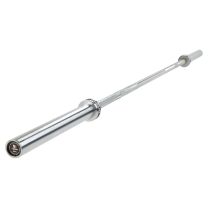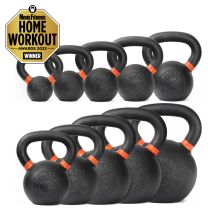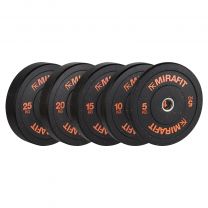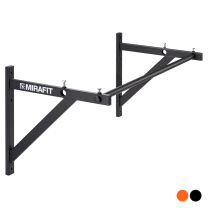Five Ways To Get Stronger
Five Ways To Get Stronger

When you first start training, increasing your weight load can be a pretty frequent occurrence.
However, when you’ve been training for a long time, it’s never usually that simple. In fact, racking up the number of plates on your bar can end up being a monthly or even yearly event.
Progression can be slow and it can often feel like you’re stuck in a rut.
The trouble is, what works for you when you first start weightlifting doesn't always work later on. And as we know, doing the same thing over and over isn't going to help you progress.
At this point, what you're looking to do is maintain that consistency in terms of progression but at the same time, vary the structure of your workout so that you don't stagnate.
HOW TO GET STRONGER
1 - ACCESSORY AND SUPPLEMENTAL TRAINING

Every body type is different and there are always going to be things that we need to work on specifically to address any weak points. If you have a slight curve in your back when you squat, or your hips keep lifting off the Weight Bench when you press, adding more weight isn't going to help.
Accessory and supplemental training are ways you can address your form and strength, as well as any weak links in the chain.
In a nutshell, supplemental training is about focusing your nervous system and your joints (as well as your muscles) to be able to handle a greater load. So, with regards to the three main exercises: bench presses, squats and deadlifts, you'll want to up the weight load, drop the reps, but train with the specific intent of progression.
This means you're more likely going to be doing something like pin squats or supramaximal holds with around 25% of your one-rep max added on, but you won't be moving very far with it.
If you're squatting, try to do a quarter of a squat, so that you're actually taking the weight properly, but not going all the way down. Hold for around five seconds, then go back up. Make sure your safety bars are in place and we'd always recommend training with an experienced spotter.
Accessory training is essentially about targeting your weak spots. This means lightening the load so you can work your way back up through a range of exercises. And although doing squats helps you get better at squats, there are lots of other things you can do too.
It's also about identifying where you're having issues and then using endurance techniques (lighter load but with more reps) to improve your overall performance. Doing this is also great for preventing imbalances and injuries.
Accessory movements can include exercises such as kettlebell swings (for hip hinge practice), farmer's walks, pull ups, dips and walking barbell lunges.
2 - HIGH FREQUENCY TRAINING (HFT)

High Frequency Training goes against how most people understand strengthening works. But that's the beauty of it. It's definitely something that needs to be implemented over a long period of time so don't expect a quick fix. But if you're committed to your training, it's something you can include pretty easily.
And even if you're not in the current possession of a garage gym, you can still fit in daily reps without too much of a problem.
'Start off small and work your way up' is fundamentally what this style of training is all about.
Choose an exercise that you really want to develop – examples include pull ups, push ups, dips and lunges – and remove it from your usual routine.
Start small and get the technique right. If your maximum number of pull ups is 20, do 10 and then stop. On the next day do 11 etc. and keep going over the course of several months. As you get higher and higher, break it up into sets.
You won't notice the benefits straight away. But eventually you'll have worked your way up to doing several hundred pull ups in one day and you'll really start to notice the benefits this sort of training has on your level strength. It's almost like you're not giving your body a choice but to adapt and keep giving you more.
Persevere, do your reps every single day, keep track and you'll start to see results.
3 - DELOAD

Deloading is about recovery. When you train day-in, day-out, your muscles understandably need a chance to repair.
And whether you choose to rest completely for a week, or just take it down to 50% of your usual weight load, this is a great way of giving your muscles some time out.
That way, when you return a week later, you are feeling refreshed and ready to get back on it.
It might not be the best idea to try and lift more straight away. When you head back, start out with the same weight load that you were lifting before you took a week off. And then with a good amount of focus, you should be able to push yourself further, and up the load the following week.
Deloading is a great training technique and something you can employ regularly to keep up your level of progression.
4 - KEEPING TRACK OF YOUR NUMBERS

Training can be really complex. If you've ever stopped to ask Google what you thought was a simple question about weightlifting, you'll know what we mean.
This in turn can be overwhelming when it comes to designing a workout routine.
The key point is that you are truly pushing yourself. If your three-rep max could actually be a four-rep max – or even a five-rep max, you know you could be doing more.
Keep track of your weights and make sure you are pushing yourself each time you train to find your true limitations.
5 - VARY YOUR TRAINING

Our bodies are great at adapting, so it's important you vary your workout as much as possible. Whether that means pushing your weight loads, changing the types of exercises you're doing (e.g. narrow grip vs wide grip etc.) or changing your style of training.
Try incorporating isometric and eccentric exercises into your routine to help your muscles continue to progress.
And if you are at a particular sticking point, think creatively. Address any weak points by focusing them, and see how you can start to lift more. This might involve doing things like half presses or pin squats. You may want to start involving some holds. Or you might want to add on some fractional plates to start pushing your one-rep max up to a two-rep max.
Lastly, it's also really important to remember that everyone is different. Every body type is different, training styles, old injuries, weaknesses, strengths etc – they all play a part.
Push yourself, persevere and progress will be yours.
For more content, follow us on Instagram, YouTube, TikTok, and on our official Mirafit Facebook page.
Enter your email to signup to our newsletter







